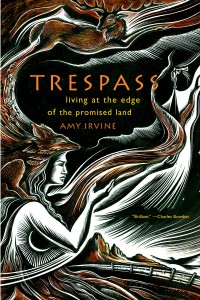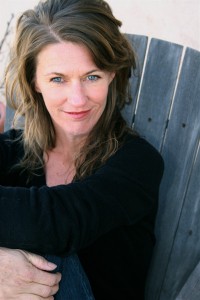by Rebecca LeBoeuf
Amy Irvine is an environmental nonfiction and memoir author. Her two books, “Trespass: Living at the Edge of the Promised Land” (2008) and “Making a Difference: Stories of How the Outdoor Industry and Individuals are Working to Preserve America’s Natural Places” (2001), have been praised in reviews by Booklist.
Irvine has been published in “America’s Best Science & Nature Writing,” “Orion,” “Climbing,” “High Desert Journal” and “Triquarterly,” to name a few. Currently, she is finishing “Down in Flames,” a collection of essays that will be published by Counterpoint Press.
Irvine is a mother and an adjunct professor in the Southern New Hampshire University Low-Residency MFA Creative Writing Program.
Have you always written?
Always. My mother reminds me that, when I was three years old, I taught myself how to write the alphabet and spell my name and have written ever since. Even when I am not writing, I have this neurotic habit of typing my thoughts on some invisible keyboard.
What’s your process in developing your storyline and characters?
I write non-fiction, mostly with a personal narrative at its core, so the facts of the story and the characters are already there, which in some ways makes my job easier. But in some ways it is more difficult, because I can’t change it up if I don’t like a particular person or event. So for me, the process is more about making sense of something or someone that already exists in the world, and dramatizing it in a way that is somehow in service to a greater good. Meaning when I write about myself, I am not doing it from a narcissistic sense of myself. I am laying my story out onto a larger landscape, and trying to understand the greater world through personal experience.
What challenges do you face in your writing, and how do you overcome them?
Time and energy, to be sure. I am a single mom with a child who has chronic health issues, so it’s easy to let writing slip away, and in fact, for the past decade, it did slip away far too often. What I learned was that I am not a very good model for my daughter if I sacrifice my work completely. So even when she is struggling, I now make time to write, even if it’s the middle of the night, next to a hospital bed.
What has the road to publication been like for you?
I began publishing by way of being a rock climber. I cut my teeth writing articles for outdoor publications such as Climbing, Rock & Ice and the American Alpine Journal; in particular, I wrote about being a woman in what was then a very male-dominated sport. I also wrote about my environmental concerns, about threats to the beautiful places I climbed in.
This led to a commission to write a book that detailed grassroots success stories in which some of the nation’s most wild and ecologically necessary landscapes were protected from development. That book ended up going to every member of Congress as well as the Oval Office. It was also featured in The Washington Post on Earth Day that year. After that, I was in a position to find an agent and shop around a proposal for my memoir, “Trespass.”
How do you market your work?
 Well, I am learning to use social media to both promote my writing as well as to fill writing workshops. But as a very busy working mom, this is probably the area in which I am weakest.
Well, I am learning to use social media to both promote my writing as well as to fill writing workshops. But as a very busy working mom, this is probably the area in which I am weakest.
What do you know now that you wish you knew when you first started writing?
How to stand in my fear. It’s terrifying, to put ourselves out there, to try and sell our work in order to make a living. But I think what we really fear is giving ourselves over entirely to the creative process–falling into a story so deeply that it takes us over.
Also, the aspect of being seen: When “Trespass” came out, it received strong reviews and a few awards, and it was really scary, to have my work be that visible. So when my daughter became ill, it was easy to hide behind that, and stop producing work for public consumption. But that’s no longer the case. I find that my best and most interesting work comes from being way out beyond my comfort zone.
Who are the authors that have inspired you most, and how have they inspired you?
Western writers Terry Tempest Williams, Ellen Meloy, and Charles Bowden were all very influential and supportive of my work as I moved from outdoor writing to writing more in a more literary vein, about the natural world. Each of them inspired me to speak more fiercely about environmental issues, and to trust that my perspective was worthwhile in terms of larger ecological and social concerns. I was very very fortunate to have some kind of personal as well as editorial relationship with each of them.
Also, I am indebted to my good friends and SNHU MFA faculty colleagues, Craig Childs and Diane Les Becquets, who paved the way for my two-year stint as a nonfiction fellow in SNHU’s MFA low-residency program. That experience resurrected my writing career and brought me back to teaching the craft in a first-rate program, with a first-rate faculty. It is truly one of the finest environments for learning to write well that I have ever seen.
If you keep just three books in your library, which would you choose and why?
I have become obsessed with “descent” novels, which all map the soul’s journey. I find them to be the most richly layered stories. So I would have to choose two epic descent poems, Dante’s “Divine Comedy” and Alice Notley’s “Descent of Alette.” My third book would have to be “Blood Meridian” by Cormac McCarthy because it is so raw and lyrical, and because it portrays unflinchingly the rugged West I was born into as a sixth-generation Utahan with Mormon roots.
Category:
